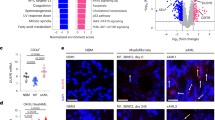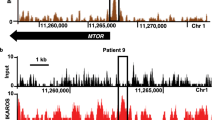Abstract
The ETV6/RUNX1 (E/R) gene fusion is generated by the t(12;21) and found in approximately 25% of childhood B-cell precursor acute lymphoblastic leukemia. In contrast to the overwhelming evidence that E/R is critical for the initiation of leukemia, its relevance for the maintenance of overt disease is less clear. To investigate this issue, we suppressed the endogenous E/R fusion protein with lentivirally transduced short hairpin RNA in the leukemia cell lines REH and AT-2, and found a distinct reduction of proliferation and cell survival. In line with the observed concurrent inactivation of the phosphoinositide 3-kinase (PI3K)/AKT/mammalian target of rapamycin (mTOR) pathway, pharmacological inhibition diminished the phosphorylation of AKT and ribosomal protein S6, and significantly increased the apoptosis rate in E/R-positive leukemias. Moreover, PI3K/mTOR inhibitors sensitized glucocorticoid-resistant REH cells to prednisolone, an observation of potential relevance for improving treatment of drug-resistant relapses. Of note, knockdown of the E/R fusion gene also severely impaired the repopulation capacity of REH cells in non-obese deficient/severe combined immunodeficient mice. Collectively, these data demonstrate that the E/R fusion protein activates the PI3K/AKT/mTOR pathway and is indispensible for disease maintenance. Importantly, these results provide a first rationale and justification for targeting the fusion gene and the PI3K/AKT/mTOR pathway therapeutically.
This is a preview of subscription content, access via your institution
Access options
Subscribe to this journal
Receive 12 print issues and online access
$259.00 per year
only $21.58 per issue
Buy this article
- Purchase on Springer Link
- Instant access to full article PDF
Prices may be subject to local taxes which are calculated during checkout




Similar content being viewed by others
Accession codes
References
Romana SP, Mauchauffe M, Le Coniat M, Chumakov I, Le Paslier D, Berger R et al. The t(12;21) of acute lymphoblastic leukemia results in a tel-AML1 gene fusion. Blood 1995; 85: 3662–3670.
Moorman AV, Ensor HM, Richards SM, Chilton L, Schwab C, Kinsey SE et al. Prognostic effect of chromosomal abnormalities in childhood B-cell precursor acute lymphoblastic leukaemia: results from the UK Medical Research Council ALL97/99 randomised trial. Lancet Oncol 2010; 11: 429–438.
Pui CH, Robison LL, Look AT . Acute lymphoblastic leukaemia. Lancet 2008; 371: 1030–1043.
Conter V, Bartram CR, Valsecchi MG, Schrauder A, Panzer-Grumayer R, Moricke A et al. Molecular response to treatment redefines all prognostic factors in children and adolescents with B-cell precursor acute lymphoblastic leukemia: results in 3184 patients of the AIEOP-BFM ALL 2000 study. Blood 2010; 115: 3206–3214.
Kuster L, Grausenburger R, Fuka G, Kaindl U, Krapf G, Inthal A et al. ETV6/RUNX1-positive relapses evolve from an ancestral clone and frequently acquire deletions of genes implicated in glucocorticoid signaling. Blood 2011; 117: 2658–2667.
Wiemels JL, Ford AM, Van Wering ER, Postma A, Greaves M . Protracted and variable latency of acute lymphoblastic leukemia after TEL-AML1 gene fusion in utero. Blood 1999; 94: 1057–1062.
Konrad M, Metzler M, Panzer S, Ostreicher I, Peham M, Repp R et al. Late relapses evolve from slow-responding subclones in t(12;21)-positive acute lymphoblastic leukemia: evidence for the persistence of a preleukemic clone. Blood 2003; 101: 3635–3640.
Panzer-Grumayer ER, Cazzaniga G, van der Velden VH, del Giudice L, Peham M, Mann G et al. Immunogenotype changes prevail in relapses of young children with TEL-AML1-positive acute lymphoblastic leukemia and derive mainly from clonal selection. Clin Cancer Res 2005; 11: 7720–7727.
Mori H, Colman SM, Xiao Z, Ford AM, Healy LE, Donaldson C et al. Chromosome translocations and covert leukemic clones are generated during normal fetal development. Proc Natl Acad Sci USA 2002; 99: 8242–8247.
Diakos C, Krapf G, Gerner C, Inthal A, Lemberger C, Ban J et al. RNAi-mediated silencing of TEL/AML1 reveals a heat-shock protein- and survivin-dependent mechanism for survival. Blood 2007; 109: 2607–2610.
Steelman LS, Abrams SL, Whelan J, Bertrand FE, Ludwig DE, Basecke J et al. Contributions of the Raf/MEK/ERK, PI3K/PTEN/Akt/mTOR and Jak/STAT pathways to leukemia. Leukemia 2008; 22: 686–707.
Kharas MG, Okabe R, Ganis JJ, Gozo M, Khandan T, Paktinat M et al. Constitutively active AKT depletes hematopoietic stem cells and induces leukemia in mice. Blood 2010; 115: 1406–1415.
McCubrey JA, Steelman LS, Abrams SL, Bertrand FE, Ludwig DE, Basecke J et al. Targeting survival cascades induced by activation of Ras/Raf/MEK/ERK, PI3K/PTEN/Akt/mTOR and Jak/STAT pathways for effective leukemia therapy. Leukemia 2008; 22: 708–722.
Gutierrez A, Sanda T, Grebliunaite R, Carracedo A, Salmena L, Ahn Y et al. High frequency of PTEN, PI3K, and AKT abnormalities in T-cell acute lymphoblastic leukemia. Blood 2009; 114: 647–650.
Gandemer V, Rio AG, de Tayrac M, Sibut V, Mottier S, Ly Sunnaram B et al. Five distinct biological processes and 14 differentially expressed genes characterize TEL/AML1-positive leukemia. BMC Genomics 2007; 8: 385.
Andersson A, Olofsson T, Lindgren D, Nilsson Br, Ritz C, Eden P et al. Molecular signatures in childhood acute leukemia and their correlations to expression patterns in normal hematopoietic subpopulations. Proc Natl Acad Sci USA 2005; 102: 19069–19074.
Ross ME, Zhou X, Song G, Shurtleff SA, Girtman K, Williams WK et al. Classification of pediatric acute lymphoblastic leukemia by gene expression profiling. Blood 2003; 102: 2951–2959.
Yeoh EJ, Ross ME, Shurtleff SA, Williams WK, Patel D, Mahfouz R et al. Classification, subtype discovery, and prediction of outcome in pediatric acute lymphoblastic leukemia by gene expression profiling. Cancer Cell 2002; 1: 133–143.
Fears S, Chakrabarti SR, Nucifora G, Rowley JD . Differential expression of TCL1 during pre-B-cell acute lymphoblastic leukemia progression. Cancer Genet Cytogenet 2002; 135: 110–119.
Inthal A, Krapf G, Beck D, Joas R, Kauer MO, Orel L et al. Role of the erythropoietin receptor in ETV6/RUNX1-positive acute lymphoblastic leukemia. Clin Cancer Res 2008; 14: 7196–7204.
Fan QW, Knight ZA, Goldenberg DD, Yu W, Mostov KE, Stokoe D et al. A dual PI3 kinase/mTOR inhibitor reveals emergent efficacy in glioma. Cancer Cell 2006; 9: 341–349.
Borkhardt A, Heidenreich O . RNA interference as a potential tool in the treatment of leukaemia. Expert Opin Biol Ther 2004; 4: 1921–1929.
Gabert J, Beillard E, van der Velden VHJ, Bi W, Grimwade D, Pallisgaard N et al. Standardization and quality control studies of /‘real-time/’ quantitative reverse transcriptase polymerase chain reaction of fusion gene transcripts for residual disease detection in leukemia—A Europe against Cancer Program. Leukemia 2003; 17: 2318–2357.
Gentleman RC, Carey VJ, Bates DM, Bolstad B, Dettling M, Dudoit S et al. Bioconductor: open software development for computational biology and bioinformatics. Genome Biol 2004; 5: R80.
Lou J, Cao W, Bernardin F, Ayyanathan K, Rauscher IF, Friedman AD . Exogenous cdk4 overcomes reduced cdk4 RNA and inhibition of G1 progression in hematopoietic cells expressing a dominant-negative CBF—a model for overcoming inhibition of proliferation by CBF oncoproteins. Oncogene 2000; 19: 2695–2703.
Strom DK, Nip J, Westendorf JJ, Linggi B, Lutterbach B, Downing JR et al. Expression of the AML-1 oncogene shortens the G(1) phase of the cell cycle. J Biol Chem 2000; 275: 3438–3445.
Bernardin F, Friedman AD . AML1 stimulates G1 to S progression via its transactivation domain. Oncogene 2002; 21: 3247–3252.
Ford AM, Palmi C, Bueno C, Hong D, Cardus P, Knight D et al. The TEL-AML1 leukemia fusion gene dysregulates the TGF-beta pathway in early B lineage progenitor cells. J Clin Invest 2009; 119: 826–836.
Krapf G, Kaindl U, Kilbey A, Fuka G, Inthal A, Joas R et al. ETV6/RUNX1 abrogates mitotic checkpoint function and targets its key player MAD2L1. Oncogene 2010; 29: 3307–3312.
Park IH, Bachmann R, Shirazi H, Chen J . Regulation of ribosomal S6 kinase 2 by mammalian target of rapamycin. J Biol Chem 2002; 277: 31423–31429.
Fine BM, Stanulla M, Schrappe M, Ho M, Viehmann S, Harbott J et al. Gene expression patterns associated with recurrent chromosomal translocations in acute lymphoblastic leukemia. Blood 2004; 103: 1043–1049.
Den Boer ML, van Slegtenhorst M, De Menezes RX, Cheok MH, Buijs-Gladdines JG, Peters ST et al. A subtype of childhood acute lymphoblastic leukaemia with poor treatment outcome: a genome-wide classification study. Lancet Oncol 2009; 10: 125–134.
Fuka G, Kauer M, Kofler R, Haas OA, Panzer-Grumayer R . The leukemia-specific fusion gene ETV6/RUNX1 perturbs distinct key biological functions primarily by gene repression. PLoS One 2011; 6: e26348.
De Vita S, Canzonetta C, Mulligan C, Delom F, Groet J, Baldo C et al. Trisomic dose of several chromosome 21 genes perturbs haematopoietic stem and progenitor cell differentiation in Down's syndrome. Oncogene 2010; 29: 6102–6114.
Masson K, Ronnstrand L . Oncogenic signaling from the hematopoietic growth factor receptors c-Kit and Flt3. Cell Signal 2009; 21: 1717–1726.
Hanahan D, Weinberg RA . The hallmarks of cancer. Cell 2000; 100: 57–70.
Wotton S, Terry A, Kilbey A, Jenkins A, Herzyk P, Cameron E et al. Gene array analysis reveals a common Runx transcriptional programme controlling cell adhesion and survival. Oncogene 2008; 27: 5856–5866.
Frost BM, Forestier E, Gustafsson G, Nygren P, Hellebostad M, Jonsson OG et al. Translocation t(12;21) is related to in vitro cellular drug sensitivity to doxorubicin and etoposide in childhood acute lymphoblastic leukemia. Blood 2004; 104: 2452–2457.
Felsher DW . Oncogene addiction versus oncogene amnesia: perhaps more than just a bad habit? Cancer Res 2008; 68: 3081–3086.
Zaliova M, Madzo J, Cario G, Trka J . Revealing the role of TEL/AML1 for leukemic cell survival by RNAi-mediated silencing. Leukemia 2011; 25: 313–320.
Horton SJ, Walf-Vorderwulbecke V, Chatters SJ, Sebire NJ, de Boer J, Williams O . Acute myeloid leukemia induced by MLL-ENL is cured by oncogene ablation despite acquisition of complex genetic abnormalities. Blood 2009; 113: 4922–4929.
Thomas M, Gessner A, Vornlocher H-P, Hadwiger P, Greil J, Heidenreich O . Targeting MLL-AF4 with short interfering RNAs inhibits clonogenicity and engraftment of t(4;11)-positive human leukemic cells. Blood 2005; 106: 3559–3566.
Gessner A, Thomas M, Castro PG, Buchler L, Scholz A, Brummendorf TH et al. Leukemic fusion genes MLL/AF4 and AML1/MTG8 support leukemic self-renewal by controlling expression of the telomerase subunit TERT. Leukemia 2010; 24: 1751–1759.
Anderson K, Lutz C, van Delft FW, Bateman CM, Guo Y, Colman SM et al. Genetic variegation of clonal architecture and propagating cells in leukaemia. Nature 2011; 469: 356–361.
Acknowledgements
We thank patients and their parents as well as physicians involved in this study. We like to acknowledge Veronika Sexl for support with xenograft mouse models, Andishe Attarbaschi for providing patient samples, Angela Schumich for assistance in flow cytometric analyses, Ruth Joas for support in quantitative real-time polymerase chain reaction, Ulrike Pötschger for help with statistics and Marion Zavadil for proofreading. This work was supported by the Austrian National Bank ÖNB (12213 and 13466), the St Anna Kinderkrebsforschung and GENAU-CHILD Projekt (GZ200.136/1–VI/1/2005) to RP-G.
AUTHOR CONTRIBUTIONS
GF designed and performed research, compiled data and drafted the manuscript. RG, AI, GK and UK carried out additional experimental work. HPK, EB and DS were responsible for mouse experiments, MK conducted bioinformatic analyses, MND assisted in phospho-flow stainings, OAH interpreted data and wrote the manuscript and RP-G conceived the study, analyzed and interpreted data and wrote the manuscript. All authors read and approved the manuscript.
Deposition of microarrays: Microarray data are available online at GEO (www.ncbi.nlm.nih.gov/geo/, accession number GSE29639).
Author information
Authors and Affiliations
Corresponding author
Ethics declarations
Competing interests
The authors declare no conflict of interest.
Additional information
Supplementary Information accompanies the paper on the Leukemia website
Rights and permissions
About this article
Cite this article
Fuka, G., Kantner, HP., Grausenburger, R. et al. Silencing of ETV6/RUNX1 abrogates PI3K/AKT/mTOR signaling and impairs reconstitution of leukemia in xenografts. Leukemia 26, 927–933 (2012). https://doi.org/10.1038/leu.2011.322
Received:
Revised:
Accepted:
Published:
Issue Date:
DOI: https://doi.org/10.1038/leu.2011.322
Keywords
This article is cited by
-
Functional characterization of the PI3K/AKT/MTOR signaling pathway for targeted therapy in B-precursor acute lymphoblastic leukemia
Cancer Gene Therapy (2022)
-
RUNX1 mutations in blast-phase chronic myeloid leukemia associate with distinct phenotypes, transcriptional profiles, and drug responses
Leukemia (2021)
-
A phase I study of a dual PI3-kinase/mTOR inhibitor BEZ235 in adult patients with relapsed or refractory acute leukemia
BMC Pharmacology and Toxicology (2020)
-
An updated review of the H19 lncRNA in human cancer: molecular mechanism and diagnostic and therapeutic importance
Molecular Biology Reports (2020)
-
Role of PI3K/AKT pathway in cancer: the framework of malignant behavior
Molecular Biology Reports (2020)



